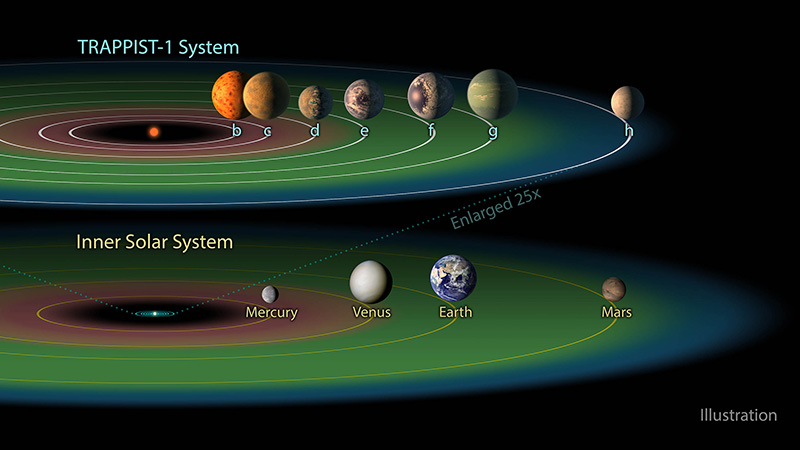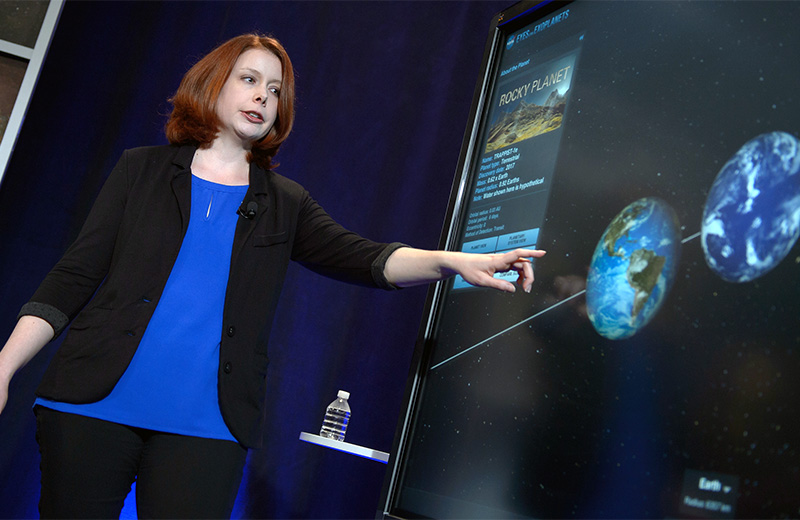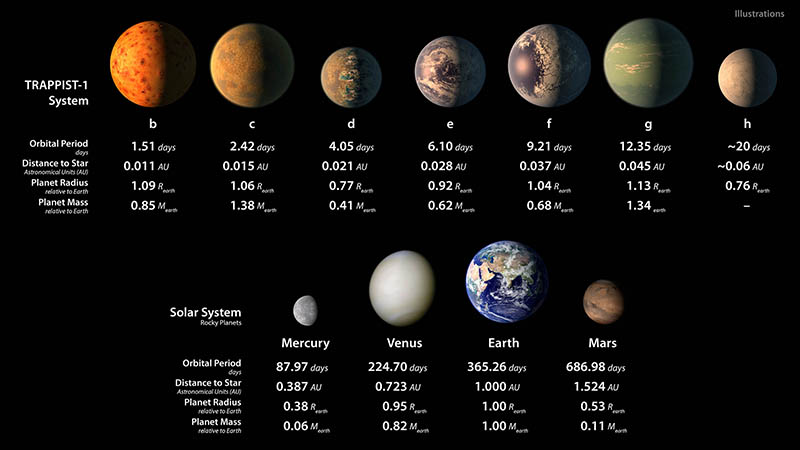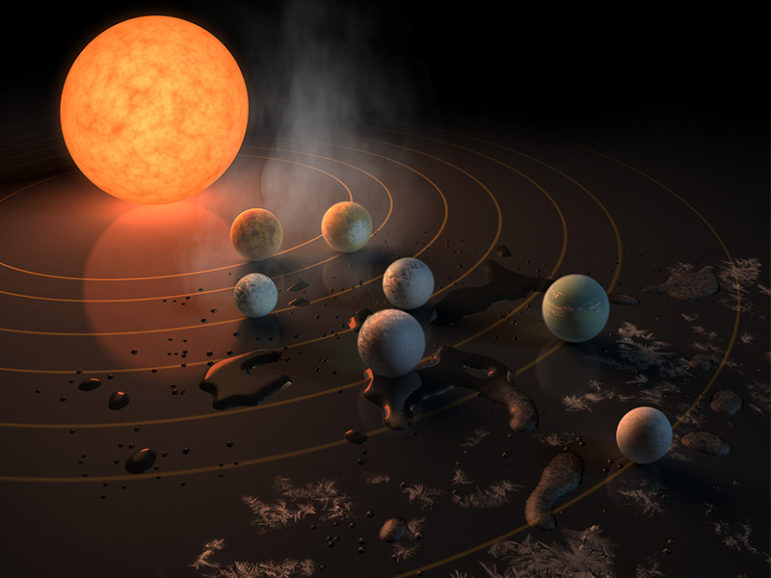(RNS) For millennia, people have gazed into the night sky and wondered, “Are we alone?”
Now the discovery of seven Earth-sized planets orbiting a nearby dwarf star, Trappist-1, has brought us not just a step, but a leap closer to answering that question, according to the scientists who announced it in a Feb. 22 press conference recorded by NASA.
“The discovery gives us a hint that finding a second Earth is not just a matter of ‘if’ but ‘when,’” said Thomas Zurbuchen, associate administrator of the Science Mission Directorate at NASA.
It’s the first time so many Earth-sized planets have been found around one star; three of them, within the so-called “habitable” or “Goldilocks” zone where liquid water could form on the surface and support life, according to NASA.
Proof of extraterrestrial life on one of any of the planets orbiting Trappist-1 would answer the big question of whether we are alone in the universe. But it also would raise many more — some, with theological implications.
[ad number=”1″]
“I have always seen the search for life elsewhere to be an opportunity to understand basically the way we relate to the universe — sort of our location,” said the Rev. Lucas Mix, an Episcopal priest and astrobiologist who has a doctorate in evolutionary biology.

The TRAPPIST-1 system contains a total of seven planets, all around the size of Earth. Three of them — TRAPPIST-1 e, f and g — dwell in their star’s so-called habitable zone. The habitable zone, or Goldilocks zone, is a band around every star (shown here in green) where astronomers have calculated that temperatures are just right — not too hot, not too cold — for liquid water to pool on the surface of an Earth-like world. Image courtesy of NASA
“My greatest hope would be that we find life somewhere else because when we find life somewhere else, we can start to talk about what it means to be alive and not what it means to be us.”
Throughout the history of theology, Mix said, Christians have swung between the idea that Earth can be the only inhabited planet because God favors humans, and its counterpart, that to assume Earth is the only inhabited planet is the height of human pride because God is limitless and all-powerful.
[ad number=”2″]
The astrobiologist-priest doesn’t see the existence of life on other planets as a challenge to the idea God loves humans and created them on this planet.
Neither do people in other traditions.
A survey of more than 1,300 people of all faiths and no faiths presented at the 2011 Mutual UFO Network Symposium by Ted Peters — research professor emeritus at Pacific Lutheran Theological Seminary, the Center for Theology and the Natural Sciences and the Graduate Theological Union in Berkeley, Calif. — found most don’t believe proof of extraterrestrial life would cause them a crisis of faith. That number is highest among Buddhists (94 percent) and lowest among Catholics (83 percent).
RELATED: For UFO enthusiasts at Oregon festival, ‘it’s all extraterrestrial’
“In Islam, the God incarnate issue does not exist, so the existence of such species would not pose fundamental problems,” said Nidhal Guessom, professor and interim head of physics at the American University of Sharjah in the United Arab Emirates, who has spoken about the implications finding extraterrestrial life would have for Muslims.

Astronomer at the Space Telescope Science Institute in Baltimore Nikole Lewis presents research findings during a TRAPPIST-1 planets briefing on Feb. 22, 2017, at NASA Headquarters in Washington, D.C. Researchers revealed the first known system of seven Earth-size planets around a single star called TRAPPIST-1. Photo courtesy of NASA/Bill Ingalls
Muslims interpret Scripture in different ways on that possibility, ranging from believing God created only humans as intelligent and spiritual beings to believing God created other species more intelligent and spiritual than us, said Guessom in an email to RNS. And different questions would be raised by different kinds of life, by bacteria or a super-intelligent species.
But “brief, intriguing, and inconclusive” references in the Quran leave the possibility open, the Algerian astrophysicist said.
[ad number=”3″]
As for Jewish and Christian Scriptures, Brother Guy Consalmagno, director of the Vatican Observatory, said: “It’s important to realize that Scripture is really clear only about one thing when it comes to creation: that God did it.”
The idea that humans are special came not from Christianity, but from the Enlightenment — from humanists interested in putting humans in God’s place, according to Consalmagno, who addressed questions raised by extraterrestrial life in a book he co-wrote titled “Would You Baptize an Extraterrestrial?: … and Other Questions from the Astronomers’ In-box at the Vatican Observatory.”

This chart shows, on the top row, artist concepts of the seven planets of TRAPPIST-1 with their orbital periods, distances from their star, radii and masses as compared to those of Earth. On the bottom row, the same numbers are displayed for the bodies of our inner solar system: Mercury, Venus, Earth and Mars. The TRAPPIST-1 planets orbit their star extremely closely, with periods ranging from 1.5 to only about 20 days. This is much shorter than the period of Mercury, which orbits our sun in about 88 days. The artist concepts show what the TRAPPIST-1 planetary system may look like, based on available data about their diameters, masses and distances from the host star. Image courtesy of NASA
Still, he said, the fact that planets orbiting Trappist-1 could support life isn’t even the most exciting part of their discovery; there probably are a “zillion” planets in the universe that could be habitable.
More exciting to him is the fact the planets are so close to the star they orbit “we have no idea how that’s even stable,” he said. That’s going to tell scientists more about how planets form.
In that way, science and religion are more alike than different.
“People get really, really excited about apparitions of saints and the Virgin Mary or whatever sounds spectacular, but in real life, your ordinary prayer life is frankly much richer and much more important than any presumed apparition that may or may not have occurred,” he said.
“That’s the way it is in science. Really, the everyday, step-by-step progress in the long run is much more exciting.”







